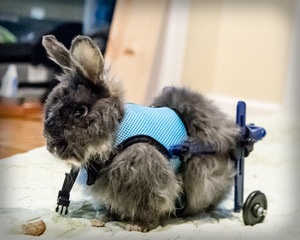Paralysis is defined as loss of the ability to move a body part. Paresis is defined as slight or partial paralysis. Unfortunately, companion rabbits sometimes suffer paresis of the hind limbs that makes them unable to stand with those legs, and to locomote normally.
There are many possible reasons a rabbit can lose the use of the back legs, including, but not limited to
- trauma to the spine, pelvis, or limbs
- spondylosis/osteoarthritis of the spine or pelvis
- degenerated, damaged, or ruptured vertebral discs
- the microsporidian parasite, Encephalitozoon cuniculi
- bacterial infection
- the roundworm parasite Baylisascaris procyoni
- general weakness associated with illness
For a complete overview of this condition, read Hind Limb Weakness in the Rabbit (archived at the Wayback Machine) by Susan Brown, D.V.M.
If your rabbit:
- shows signs of wobbliness or weakness in the rear legs
- begins to develop an unsual, hunched gait with respect to the back legs
- occasionally has trouble staying upright
- occasionally falls over during normal activities
it is wise to get him/her to a rabbit-experienced veterinarian as soon as possible. Prompt treatment of any cause of hind limb paresis (particularly trauma) is essential to give the best chance of full recovery.
Mechanical Problems
If hind limb weakness is caused by a disorder such as a break, strain, degenerative damage or other physical process, treatment will be different than if the problem is caused by a pathogen (disease-causing organism).
Trauma
A rabbit who has been injured by a predator or in an accident involving incorrect handling can suffer severe damage to the spine and soft tissue. This can result in temporary or permanent inability to use the back legs. If you know or suspect that your rabbit has suffered a traumatic injury, keep him as still as possible and do not attempt to manipulate the injured area. Placing the bunny on a firm, rigid surface (with some soft padding) to immobilize him for transport to the vet will decrease the chances of exacerbating the injury during travel.
With a traumatic injury, prompt medical attention is absolutely critical to ensuring the best chance of recovery. As injured tissues swell with inflammation, damage can be increased by loss of blood supply and pressure on important structures and nerves. Rapid administration of anti-inflammatory drugs by a qualified, rabbit-experienced veterinarian is essential. (DO NOT attempt to give your rabbit any type of drug without veterinary supervision, as many over-the-counter medications can be very dangerous to your rabbit.) Whether the damage is treatable must be determined by the vet who may recommend radiography to see the extent of the damage.
Degenerative Processes
Spondylosis, osteoarthritis, vertebral disc deterioration, and other degenerative processes can cause hind limb weakness and paralysis in rabbits. If these are suspected, your vet may wish to get a positive diagnosis via radiography. The exact treatment will depend on the cause of the problem.
Treatments for Mechanical Problems NSAIDs (non-steroidal anti-inflammatory drug) such as Metacam, or even corticosteroids in the case of severe traumatic injury may be prescribed by your vet to help reduce inflammation contributing to paresis.
Some practitioners have reported that glucosamine supplements appear to offer relief from arthritis and other degenerative skeletal problems. These will not be useful in a case of trauma, but might be something to ask the vet about if your bunny is suffering from a chronic problem. A newer product, Cetyl-M shows promise in restoring mobility in rabbits with spondylosis and other conditions making them creaky and sore. I have at least one older rabbit who noticeably regained mobility and comfort after about a week on Cetyl-M, and we have not taken him off it since we started.
Physical therapy can help increase movement in a rabbit suffering from chronic skeletal problems (although physical therapy or manipulation should NEVER be done if you know your rabbit has suffered a traumatic injury, as this can make things much worse!). Some rabbit caregivers have reported success at restoring a bunny’s movement by enlisting the services of a qualified, licensed veterinarian who is also a skilled acupuncturist. Massage, acupuncture and skeletal manipulation can sometimes make a great difference in the bunny’s mobility and quality of life.
Pathogens
Disease-causing agents or organisms are sometimes at the root of the onset of paresis. Bacterial infection or infection by certain types of parasites can cause a rabbit to lose mobility in the rear or front limbs. Treatment for this cause of paresis will, of course, differ from that given for mechanical problems.
Encephalitozoon cuniculi
Encephalitozoon cuniculi is a microsporidian (single-celled eukaryotic) parasite that resides in the renal and nervous tissue of infected rabbits. Positive diagnosis of this infection is difficult. A biopsy of renal and/or nervous tissue might reveal encysted parasites, but the risk of such a surgery presents far greater risk than the benefit of a positive diagnosis might warrant.
Presence or absence of the parasite may be indicated via blood titer test, in which the laboratory analyzes the blood for the presence of antibodies against E. cuniculi, but the value of this test is controversial. A seropositive titer–in which the lab finds antibodies against E. cuniculi in the blood serum–means only that the rabbit has been exposed at some time in his/her life, and does not necessarily indicate an active infection. However, a negative titer does not necessarily indicate that the bunny has never been exposed, since antibodies eventually can leave the system. Also, a rabbit unable to mount an immune response to E. cuniculi (for genetic or other reasons) may yield a seronegative result, even if the parasites are present. So interpretation of titer tests must be done with caution.
Because “positive” or “negative” titers are largely uninformative, many vets who do take blood to confirm the presence of E. cuniculi prefer to run a paired titer, with blood drawn twice, two weeks apart. A “rising titer” means that the second blood sample has more antibodies than the first one, and a “falling titer” means that the second blood sample has fewer antibodies than the first one.
Accurate interpretation of either result is still problematic, since:
- the rabbit has an active infection, and requires treatment OR
- the rabbit is mounting an adequate immune response, is fighting off the parasite, and does not need treatment
- the rabbit has a waning E. cuniculi infection, OR
- the rabbit’s immune system is not mounting an adequate response to an active infection, and so should be treated for E. cuniculi
Because the results of a paired titer cannot always be reliably interpreted, some veterinarians will save the expense of a blood sample, and simply treat for the parasite as a precaution.
Although the presence of E. cuniculi has been linked to neurological problems, such as torticollis and hind limb paresis, many rabbits with a positive titer never show signs of illness. Similarly, we have seen rabbits showing signs commonly linked to E. cuniculi whose blood tests come back negative. In short, there may be other, unknown causes for hind limb paresis, but in some immunosuppressed or particularly susceptible individuals, E. cuniculi may contribute to both neurological problems (e.g., torticollis or hind limb paresis) and renal disease.
Some practitioners have reported success in restoring mobility and stopping the progression of neurological symptoms with the administration of one of the benzamidazole drugs (Fenbendazole or oxibendazole are preferred. A third–albendazole–is NOT recommended for rabbits, as there are anecdotal reports of rabbits given this drug suffering from pancytopenia and death shortly after therapy was begun.). The benazmidazole drugs inhibit the normal function of tubulin protein, an essential structural component of the feeding/infective apparatus (a modified Golgi apparatus) of microsporidian parasites such as E. cuniculi.
Suter, et al. showed that rabbits treated with 20mg/kg fenbendazole once per day for 4 weeks went from seropositive for E. cuniculi to negative, and histology revealed no evidence of parasites present in the central nervous system or kidneys (the usual places they show up) of animals that had been infected with the parasite and then treated with the drug. Although fenbendazole may eliminate the parasite, there is no evidence to suggest that it can reverse neurological damage already done. However, if some of the neurological/behavioral presentations of E. cuniculi infection are due to inflammation and/or the immune response itself, elimination of the parasites along with administration of anti-inflammatory drugs may be helpful. Anecdotal reports from veterinarians and rabbit caregivers suggest that rabbits showing neurological signs may enjoy a reduction or even loss of symptoms following treatment with fenbendazole or oxibendazole.
Ponazuril (toltrazuril sulfate, marketed as Marquis or Baycox in the U.S.) is another drug that shows promise for the treatment of E. cuniculi. It was originally developed to treat Equine Protozoal Meningitis (EPM), caused by Sarcocystis neurona, a microsporidian parasite of horses. Off-label use of this drug by rabbit-experienced veterinarians is now relatively common, and anecdotal reports of improvement are encouraging.
 | Our Anecdotal Contribution Tilda was rescued with a head tilt so severe that her head was nearly upside down. She had no sign of ear infection. She was given 30 days of both fenbendazole and ponazuril, and over the course of treatment lost almost all of the head tilt. She regained full running capabilities, and became fully functional. At the time of this writing, she is thriving and has no further neurological signs. (Hey, a sample size of one is still a story.) |
Whatever the cause of your rabbit’s hind limb weakness, it definitely requires an in-person examination by a rabbit-experienced veterinarian so that appropriate treatment can be started as soon as possible. As with most ailments, the sooner treatment is begun, the better the chances for full recovery.
Literature Cited
Suter, C., Muller-Doblies, J-M. Hatt, P. Deplazes. 2001. Prevention and treatment of Encephalitozoon cuniculi infection in rabbits with fenbendazole. The Veterinary Record, 14 April 2001.

